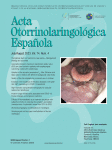Introduction
Ossiculoplasty is the surgical correction of middle ear malformations with replacement material. This procedure aims to restore as much sound transmission from the outer to the inner ear as possible where the ossicles are damaged or absent. Broadly, two main types of middle ear replacement material exist: total ossicular replacement prosthesis (TORP) for the undersurface of the tympanic membrane or malleal neck to the stapedial footplate and partial ossicular replacement prosthesis (PORP) for the undersurface of the tympanic membrane or malleal neck to the stapedial head. Given that anatomical and technical factors affect the outcomes of ossiculoplasty, improved preoperative assessment with better knowledge of the predictive value of the techniques uses should lead to greater success.1 Research by Gosselin et al.2 indicated that preoperative high-resolution computed tomography (HRCT) can be used to predict the length of the stapedotomy prosthesis before surgery. In another study, Motegi et al.3 suggested that CT and audiologic information facilitate decision-making for ossiculoplasty, specifically regarding ossicular fixation on chronic otitis media.
HRCT is used to identify anatomical structures before otologic surgery but not for evaluating ossicle length in prosthesis selection. This pilot study aims to assess the correlation between HRCT and the distance from the malleal neck to both the stapedial head and footplate in temporal bone. The results are expected to aid ossiculoplasty planning and prostheses selection by preoperative HRCT.





Add Comment